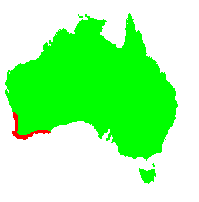 |
| Family: |
Myrtaceae |
| Distribution: |
Granite outcrops and hills in the south of Western Australia. |
| Common Name: |
Rock thryptomene |
| Derivation of Name: |
Thryptomene... apparently from Greek meaning "made small', possibly referring to the growth habit of most members of the genus.
saxicola...From Latin saxum, a rock or bolder and cola, living in or dwelling, referring to the habitat of the species. |
| Conservation Status: |
Not considered to be at risk in the wild. |
General Description:
Thryptomene is a solely Australian genus of about 40 species occurring in all states. They are generally small shrubs of about 1.5 metres high or less. They have small flowers but these often occur in a massed display which makes species such as T.saxicola and T.calycina popular as cut flowers.
T.saxicola is a small shrub to about 1 metre high with small, oval leaves about 5-10 mm long. Like many members of the myrtle family, the leaves contain aromatic oils. The small, pale-pink flowers occur in the leaf axils mainly in winter and spring but flowers will often be seen at other times of the year.
This species is cultivated in most parts of Australia and in many overseas locations as well. The form most commonly grown is 'Payne's thryptomene' (sometimes called 'Payne's hybrid' or Thryptomene 'paynei'). It is a hardy plant in well drained soils in a sunny or lightly shaded location and it is tolerent of moderate frosts. The plant responds well to pruning and this helps to develop a well-shaped and attractive bush.
Propagation from seed is unreliable. However, cuttings of hardened, current seasons growth strike readily.
[Photo Gallery Index] [Photo Gallery (text descriptions)] [Photo Gallery (thumbnail images)]
[Chamelaucium and Relatives]
Updated: Sunday 15 July 2007.
|